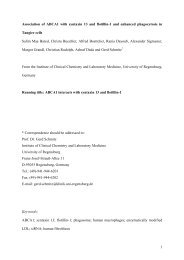SUNDAY, DECEMBER 4- Late Abstracts 1 - Molecular Biology of the ...
SUNDAY, DECEMBER 4- Late Abstracts 1 - Molecular Biology of the ...
SUNDAY, DECEMBER 4- Late Abstracts 1 - Molecular Biology of the ...
You also want an ePaper? Increase the reach of your titles
YUMPU automatically turns print PDFs into web optimized ePapers that Google loves.
<strong>SUNDAY</strong><br />
transport system inside <strong>the</strong> chloroplast similar to <strong>the</strong> transport mechanism that exists between<br />
<strong>the</strong> ER and <strong>the</strong> Golgi. CPSAR1 has a role in thylakoid biogenesis and in vesicle budding from<br />
<strong>the</strong> inner envelope membrane for fusion with <strong>the</strong> thylakoids. As this mechanism is similar to <strong>the</strong><br />
cytosolic vesicular transport, a putative model is proposed in which <strong>the</strong> CPSAR1 need o<strong>the</strong>r<br />
protein partners for <strong>the</strong> vesicular formation and transport. For this purpose we are using coimmunoprecipitation<br />
and yeast-2-hybrid for identification <strong>of</strong> protein-protein interaction involving<br />
CPSAR1. Ongoing bioinformatic studies <strong>of</strong> common motifs important for interactions and cargos<br />
<strong>of</strong> <strong>the</strong> secretory pathway gives that <strong>the</strong>y also exist for chloroplast localized proteins i.e. possible<br />
protein interactors to <strong>the</strong> chloroplast vesicle traffic system. In addition, we are studying <strong>the</strong><br />
intraplastidial role <strong>of</strong> CPSAR1 from isolated chloroplast envelopes in vitro.<br />
1995<br />
A Novel Function <strong>of</strong> AWP1/ZFAND6: Regulation <strong>of</strong> Pex5p Export by Interacting with Cysmonoubiquitinated<br />
Pex5p and AAA ATPase, Pex6p.<br />
N. Miyata 1 , K. Okumoto 1,2 , S. Mukai 1 , M. Noguchi 2 , Y. Fujiki 1,3 ; 1 Department <strong>of</strong> <strong>Biology</strong>, Faculty<br />
<strong>of</strong> Sciences, Kyushu University, Fukuoka, Japan, 2 Graduate School <strong>of</strong> Systems Life Sciences,<br />
Kyushu University, Fukuoka, Japan, 3 JST, CREST, Tokyo, Japan<br />
In biogenesis <strong>of</strong> peroxisome, a subcellular organelle, Pex5p is <strong>the</strong> shuttling receptor for<br />
peroxisomal matrix proteins harboring peroxisome-targeting signal 1 (PTS1). Several peroxins<br />
are involved in <strong>the</strong> Pex5p shuttling between <strong>the</strong> cytosol and peroxisomes. However, <strong>the</strong> precise<br />
mechanism underlying <strong>the</strong> PTS1 receptor shuttling remains elusive. We herein suggest that<br />
liver cytosol contains at least two distinct factors involved in <strong>the</strong> Pex5p export. We isolate one <strong>of</strong><br />
<strong>the</strong> factors by biochemical fractionation and in vitro Pex5p export assay and identify it as<br />
AWP1/ZFAND6 (termed p40), a ubiquitin-binding NF-κB modulator. In in vitro Pex5p export<br />
assay, recombinant p40, stimulates Pex5p export, whilst anti-p40 antibody interferes with Pex5p<br />
export. p40 interacts with AAA ATPase Pex6p, but not Pex1p-Pex6p complex. p40 binds Cysubiquitinated<br />
form <strong>of</strong> Pex5p more preferentially than unmodified Pex5p, apparently via its A20<br />
zinc-finger domain. RNA interference for p40 significantly affects <strong>the</strong> PTS1 protein import into<br />
peroxisomes. Fur<strong>the</strong>rmore, in <strong>the</strong> p40 knocked-down cells Pex5p is unstable, as in fibroblasts<br />
from patients each defective in Pex1p, Pex6p, and Pex26p, all prerequisite to <strong>the</strong> Pex5p export.<br />
Taken toge<strong>the</strong>r, p40 is a novel c<strong>of</strong>actor <strong>of</strong> Pex6p involved in <strong>the</strong> regulation <strong>of</strong> Pex5p export in<br />
peroxisome biogenesis.<br />
1996<br />
Docosahexaenoic acid is required for peroxisomal elongation, a prerequisite for division<br />
<strong>of</strong> peroxisomes.<br />
A. Itoyama 1 , M. Honsho 2 , Y. Abe 2 , Y. Yoshida 2 , Y. Fujiki 2,3 ; 1 Graduate School <strong>of</strong> Systems Life<br />
Sciences, Kyushu University, Fukuoka, Japan, 2 Department <strong>of</strong> <strong>Biology</strong>, Faculty <strong>of</strong> Sciences,<br />
Kyushu University, Fukuoka, Japan, 3 CREST, JST, Tokyo, Japan<br />
Peroxisomal division is strictly regulated by several fission factors and cellular environments. In<br />
<strong>the</strong> past decade, metabolic control <strong>of</strong> peroxisomal morphogenesis is postulated but remains<br />
largely undefined. We herein identify docosahexaenoic acid (DHA, C22:6n-3) as <strong>the</strong> regulator <strong>of</strong><br />
<strong>the</strong> peroxisomal morphogenesis. Peroxisomes are much less abundant in fibroblasts from<br />
patients defective in peroxisomal fatty-acid β-oxidation. Supplementation <strong>of</strong> DHA to such<br />
fibroblasts induces proliferation <strong>of</strong> peroxisomes up to <strong>the</strong> same level in normal fibroblasts. DHAinducible<br />
peroxisomal proliferation is abrogated upon treatment with dynamin-like protein 1<br />
siRNA, suggesting <strong>the</strong> DHA-induced division <strong>of</strong> peroxisomes. DHA-induced peroxisomal<br />
division is initiated by elongation <strong>of</strong> peroxisomes in a Pex11p-dependent manner. Fur<strong>the</strong>rmore,<br />
DHA augments hyper-oligomerization <strong>of</strong> Pex11pβ, giving rise to Pex11pβ-enriched regions on
















